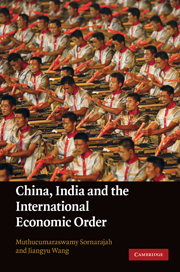Book contents
- Frontmatter
- Contents
- Notes on contributors
- Preface
- Introduction and overview
- PART I China, India and the global trade system
- PART II China, India and regional economic integration in Asia
- 10 The role of China and India in Asian regionalism
- 11 The Asian Economic Community
- 12 The China–ASEAN tariff acceleration clause
- 13 Financial cooperation and integration in East Asia
- PART III Law and development in China and India: Domestic issues
- Index
- References
12 - The China–ASEAN tariff acceleration clause
from PART II - China, India and regional economic integration in Asia
Published online by Cambridge University Press: 03 May 2011
- Frontmatter
- Contents
- Notes on contributors
- Preface
- Introduction and overview
- PART I China, India and the global trade system
- PART II China, India and regional economic integration in Asia
- 10 The role of China and India in Asian regionalism
- 11 The Asian Economic Community
- 12 The China–ASEAN tariff acceleration clause
- 13 Financial cooperation and integration in East Asia
- PART III Law and development in China and India: Domestic issues
- Index
- References
Summary
Introduction
India–China trade in the near future is likely to take place against the backdrop of an emerging, uncertain network of Asian Free Trade Agreements (FTAs). This chapter takes a look at the contemporary history of regional trade negotiations. It traces the influence of a third party; namely, ASEAN's efforts to build links to the rest of Asia through a complex network of FTAs. That influence suggests a disturbing possibility – the exportation of a tariff acceleration device developed during the ASEAN–China negotiations to the rest of Asia. The ASEAN–China FTA contains a tariff acceleration clause and similar devices which would allow separate bilateral deals between China and the individual ASEAN nations to be cut beneath the larger umbrella of the China–ASEAN FTA.
These devices are significant because ASEAN has become something of a common medium for India and the ‘Plus 3’ nations to join in the build-up of a regional network of Asia-wide FTAs. In the near to medium term, the Plus 3 are unlikely to have bilateral agreements between themselves. There is no evidence that China, Japan and South Korea will be aiming for FTAs between themselves anytime soon. Instead, they appear content to trade with each other on preferential terms through their individual FTAs with ASEAN and the ASEAN nations instead. If these become as heavily bilateralized as the China–ASEAN FTA, the result could be an ‘MFN black hole’ in intra-Asian trade liberalization.
- Type
- Chapter
- Information
- China, India and the International Economic Order , pp. 427 - 453Publisher: Cambridge University PressPrint publication year: 2010



